Overview
To achieve success in large auger rental for construction projects, it is essential to follow five critical steps:
- Evaluating task requirements
- Collecting necessary permits
- Ensuring safety gear is available
- Selecting the appropriate auger
- Understanding rental terms
Each of these steps plays a vital role in the overall process. For instance, proper planning and compliance with regulations not only enhance efficiency but also help avoid unexpected costs during the rental process. By meticulously addressing each step, you position yourself for a seamless rental experience.
Evaluating task requirements is the first step in this process. Understanding the specific needs of your project allows you to choose the right equipment, thereby maximizing productivity. Additionally, collecting the necessary permits ensures compliance with local regulations, which is crucial for avoiding potential legal issues. When these foundational steps are executed effectively, the likelihood of a successful project increases significantly.
Safety gear availability cannot be overlooked. Ensuring that all personnel are equipped with the proper safety equipment protects your team and promotes a culture of safety on-site. This commitment to safety not only safeguards your workers but also reflects positively on your organization’s reputation. Furthermore, selecting the appropriate auger is paramount; the right tool can make all the difference in achieving project goals efficiently.
Lastly, understanding rental terms is essential. Familiarizing yourself with the conditions of the rental agreement ensures that you are prepared for any obligations or limitations. This knowledge empowers you to make informed decisions and fosters a smoother rental process. In conclusion, by following these five steps, you can ensure a successful large auger rental experience that meets your construction project needs.
Key Highlights:
- Evaluate task requirements before renting an auger, including soil type, hole dimensions, and project scope.
- Collect necessary permits, as about 84% of construction projects in the U.S. require them.
- Ensure you have appropriate safety gear, such as gloves, goggles, and hard hats.
- Create a checklist for auger rental requirements, including type needed, specifications, permits, safety equipment, and rental provider contact information.
- Select the right drill based on project needs, considering options like hand-held, gas-powered, or hydraulic drills.
- Review leasing contracts carefully, paying attention to pricing, deposits, and delivery options.
- Understand rental terms, including lease duration, late fees, and maintenance responsibilities.
- Document pre-existing damages to avoid liability for issues not caused by you.
- Clean the auger before returning it to avoid cleaning fees, and ensure it is returned on time to prevent late charges.
- Provide feedback to the rental company after returning the auger to foster a positive relationship for future rentals.
Introduction
Navigating the complexities of construction projects often hinges on the effective use of specialized equipment; large augers are no exception. A significant portion of construction efforts necessitates precise drilling, and understanding the nuances of auger rental can greatly enhance project efficiency and success. But what are the key steps to ensure a seamless rental experience that avoids costly pitfalls?
By exploring the following aspects, contractors can empower themselves to make informed decisions and optimize their project outcomes:
- Essential preparations
- Selection criteria
- Return processes
Prepare for Your Auger Rental
Before proceeding with a large auger rental, it is essential to thoroughly evaluate your task requirements. Start by determining the type of soil you will be working with, as this influences the choice of auger. Additionally, specify the depth and diameter of the holes needed, along with the overall extent of your undertaking. It is crucial to collect any required permits or approvals needed for your work location, as approximately 84% of construction endeavors in the U.S. demand some form of permitting for machinery leasing.
Ensure you have the appropriate safety gear, including gloves, goggles, and hard hats, to protect yourself during operation. To simplify the leasing process for large auger rental and prevent missing essential details, develop a thorough checklist of your requirements. This checklist should include:
- Type of auger required based on soil conditions
- Depth and diameter specifications
- Necessary permits and approvals
- Safety equipment checklist
- Contact information for your rental provider
By following these steps, you can enhance the efficiency of your auger rental process and ensure that your construction project proceeds smoothly.
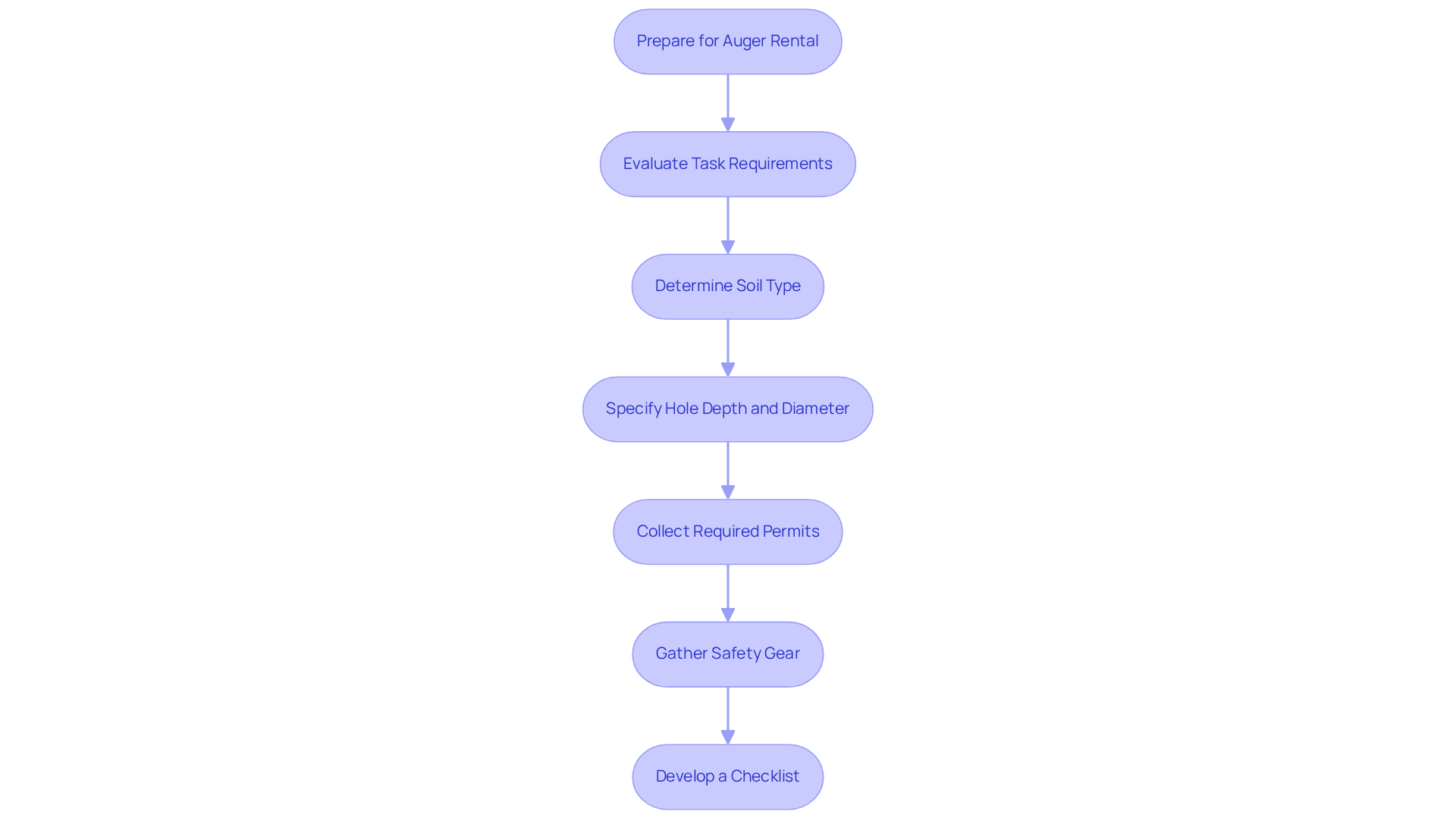
Choose the Right Auger for Your Project
When selecting the appropriate drill for your construction project, it is crucial to consider the specific requirements of the task at hand. Various types of drilling tools are available, including hand-held, gas-powered, and hydraulic options. For smaller tasks, a hand-held drill may be sufficient; however, larger endeavors typically demand the strength and efficiency of gas or hydraulic tools.
Assessing the drill's diameter, length, and flight pitch is essential to ensure alignment with your project specifications. For instance, Terex recommends using a thicker flight at the base of a screw conveyor for heavy-duty applications, significantly enhancing performance.
Moreover, earth drills can save hours of labor compared to manual digging, making them a valuable investment for efficiency. Consulting with the leasing company can yield crucial insights and tailored recommendations, leveraging their expertise and extensive inventory to optimize your project outcomes. Their knowledgeable team is equipped to assist in identifying the best drill type for various applications, such as:
- Post-hole digging
- Fence installation
- Landscaping tasks
Take action now to ensure your project is equipped with the right tools for success.
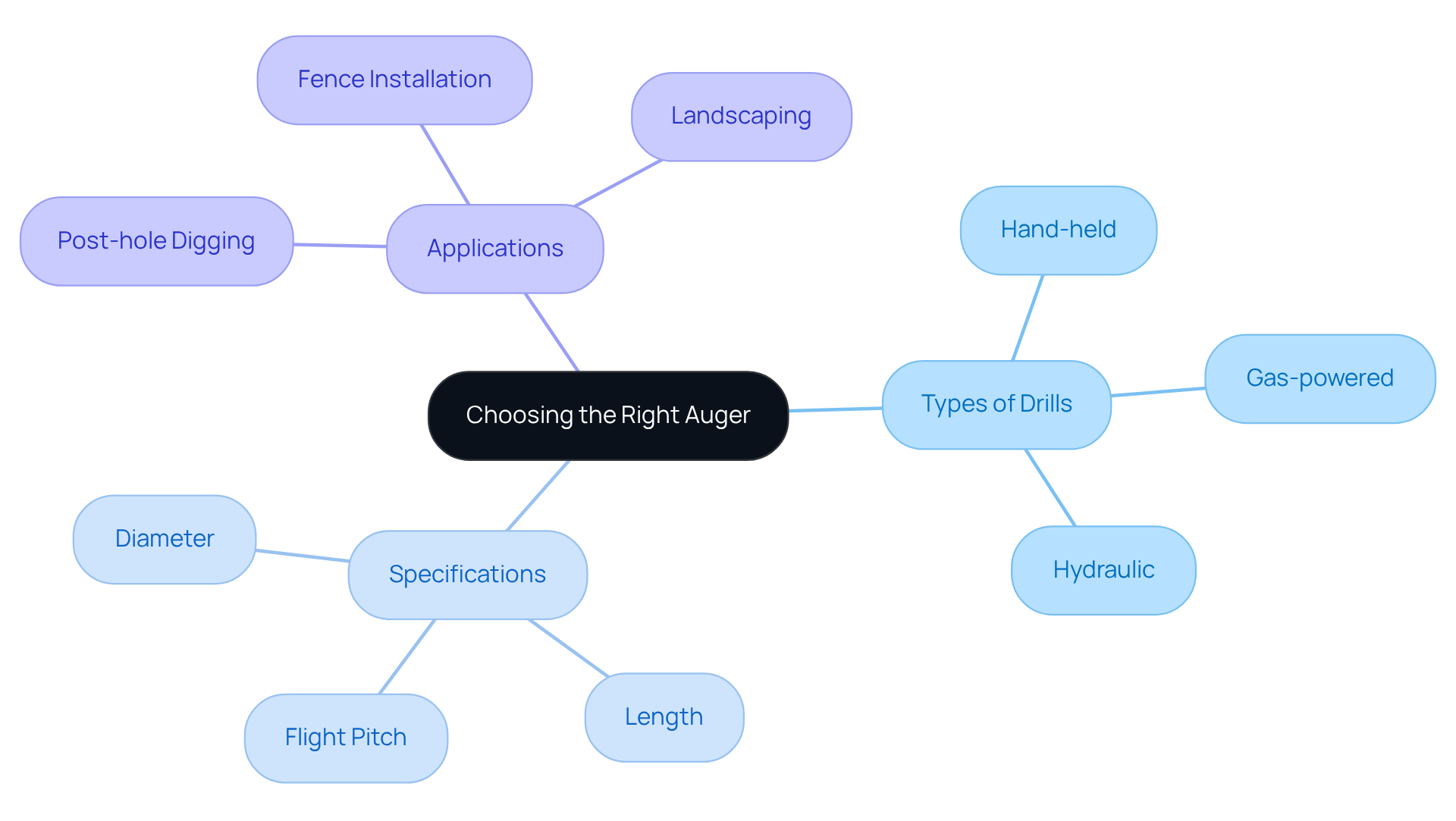
Complete the Rental Process
To successfully complete the leasing process for an auger, begin by contacting EZ Equipment Rental to confirm the availability of . Provide comprehensive details about your project, including the expected lease duration and any specific requirements you may have.
Carefully review the leasing contract, paying close attention to vital conditions such as:
- Pricing
- Deposit requirements
- Options for pickup or delivery
Once you are satisfied with the terms, finalize the lease by signing the agreement and making any necessary payments. It is crucial to retain a copy of the lease agreement for your records, as this documentation will help prevent misunderstandings and ensure clarity throughout the leasing period.
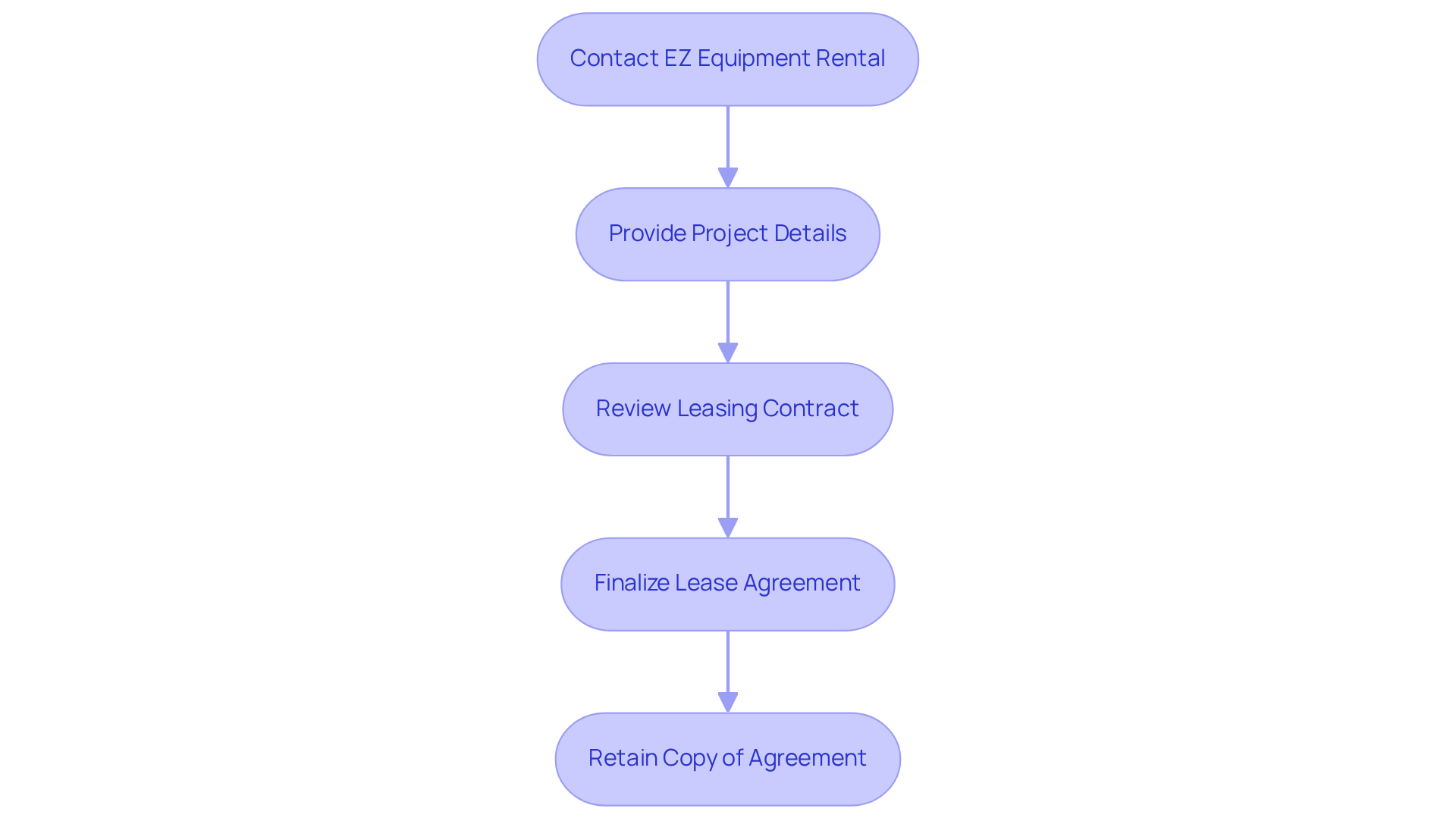
Understand Rental Terms and Conditions
Thoroughly reviewing lease terms and conditions is essential before signing any agreement. Focus on key aspects such as lease duration, late fees, and potential charges for damages or excessive wear. Notably, numerous leasing firms impose late charges that can significantly impact your budget, with typical late fees often reaching as much as 20% of the leasing price. Understanding the policies regarding equipment maintenance and operation, as well as the procedures for reporting issues or malfunctions, is crucial.
Furthermore, documenting pre-existing damage is vital, as it protects you from liability for issues not caused by you. As Newman Tractor states, "Overlooking or misunderstanding any part of this agreement can lead to unexpected costs, disputes, or even legal actions."
If uncertainties arise, do not hesitate to seek clarification from the leasing company. This proactive approach not only aids in avoiding misunderstandings but also ensures a smooth experience, ultimately contributing to the success of your construction endeavor.
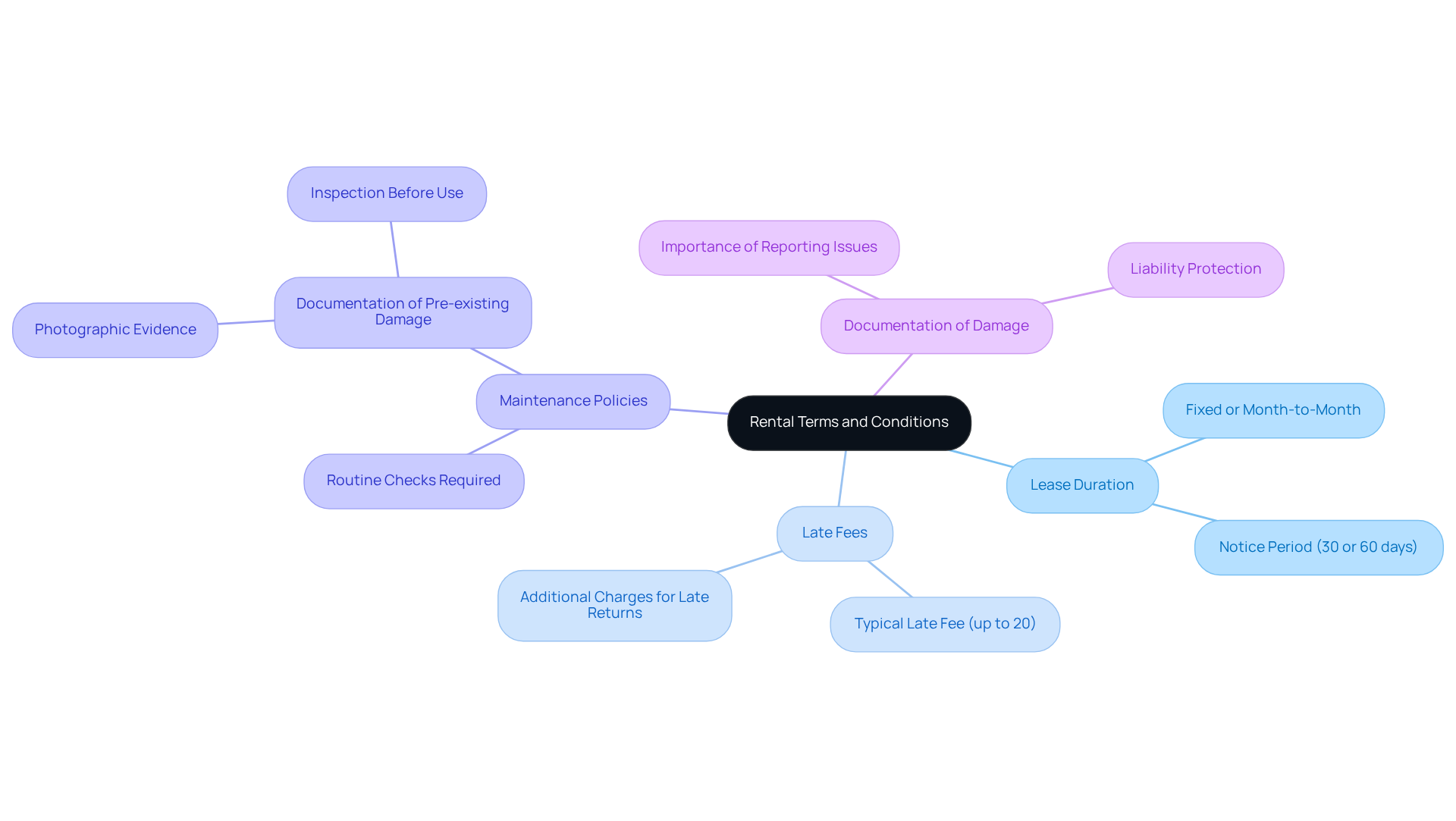
Return the Auger and Follow Up
Upon completing your project, it is crucial to prepare for the return of the large auger rental. Begin by thoroughly cleaning the tools to eliminate any dirt or debris, as many rental companies impose cleaning fees for items returned in unsatisfactory condition. A cleaning fee of $25 is commonly charged for wet or dirty tools. All equipment must be returned clean, dry, and in good working order, accompanied by all parts and accessories. Following this, conduct a thorough examination of the device, documenting any damages or issues that may have arisen during your rental period. This proactive approach can help prevent disputes regarding the item's condition upon return.
Ensure that you return the drill on or before the due date to avoid incurring late fees, typically charged daily per item until the equipment is returned. Keep in mind that all returns are due one hour before the Adventure Center closes on the due date. When returning the large auger rental, be sure to review the lease contract with the leasing company to confirm that all conditions have been met and that there are no outstanding issues.
Finally, consider reaching out to the leasing company to provide feedback on your experience. This not only aids them in improving their services but also fosters a positive relationship for future bookings. By following these best practices, you can ensure a seamless return process and maintain a favorable standing with your rental provider.
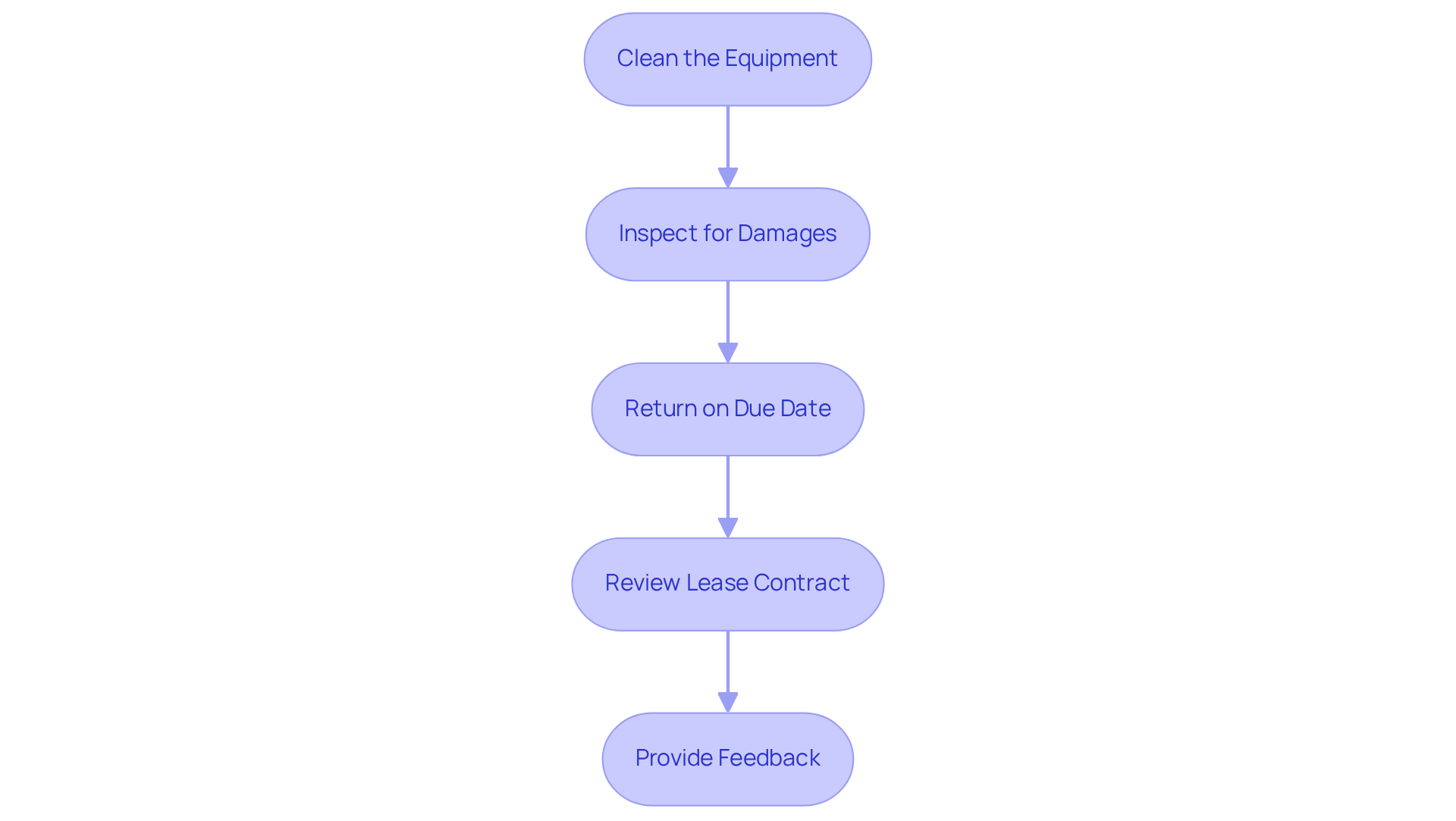
Conclusion
Successfully navigating the process of large auger rental in construction projects necessitates meticulous planning and execution. By comprehensively understanding the essential steps—from preparation and selection to the completion of the rental process and proper return—construction professionals can ensure their projects operate efficiently and effectively.
Key insights underscore the significance of:
- Evaluating soil conditions
- Selecting the appropriate type of auger
- Thoroughly reviewing rental agreements
Each step, from gathering necessary permits to maintaining clear communication with rental providers, contributes to a seamless experience. Furthermore, grasping rental terms and conditions can help avoid unexpected costs and disputes, while adhering to proper equipment return practices fosters positive relationships with rental companies.
Ultimately, dedicating time to preparation and following best practices not only enhances the success of auger rentals but also bolsters the overall efficiency of construction projects. Emphasizing thorough preparation, informed decision-making, and proactive communication can lead to improved outcomes. As construction professionals embark on future projects, applying these insights will undoubtedly pave the way for continued success in their endeavors.
Frequently Asked Questions
What should I do before renting a large auger?
Before renting a large auger, evaluate your task requirements by determining the type of soil, specifying the depth and diameter of the holes needed, and collecting any necessary permits or approvals for your work location.
Why is it important to understand the soil type when renting an auger?
The type of soil influences the choice of auger, as different augers are designed to work effectively in various soil conditions.
What safety gear is recommended for operating an auger?
It is recommended to wear gloves, goggles, and hard hats to protect yourself during auger operation.
What should be included in a checklist for auger rental?
Your checklist should include the type of auger required based on soil conditions, depth and diameter specifications, necessary permits and approvals, a safety equipment checklist, and contact information for your rental provider.
What types of drilling tools are available for construction projects?
Available drilling tools include hand-held drills, gas-powered drills, and hydraulic drills, with the choice depending on the size and requirements of the task.
How do I choose the right auger for my project?
To choose the right auger, assess the drill's diameter, length, and flight pitch to ensure they align with your project specifications. Consulting with the leasing company can also provide tailored recommendations.
What are some applications for earth drills?
Earth drills can be used for various applications, including post-hole digging, fence installation, and landscaping tasks.
How can earth drills improve project efficiency?
Earth drills can save hours of labor compared to manual digging, making them a valuable investment for improving efficiency in construction projects.




